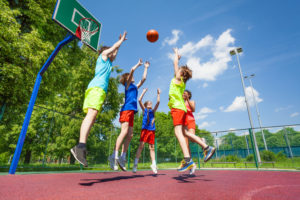Promoting physical activity and getting creative about encouraging kids to move is good for the body and the mind
“It doesn’t matter how you move, only that you get up and move. I encourage our school community to find something they like and get moving. Walk, run, bike, swim — just move.”
Georgia physical education teacher Teresa Wheeler, a 2016 Thriving Schools Honor Roll Champion, knows that good physical health leads to wellness improvements in many areas of life.
She uses her expertise to inspire others — students, school staff, and the community — to take up efforts that support overall health and wellness.
“I believe that students at the elementary level need to be active to help their overall health. A student who has daily physical activity will have a better chance at academic success,” she said. “One of my favorite quotes is, ‘Learn to play, play to learn.’”
With spring break approaching, it’s time to make a plan to keep students active.
Children need to be engaged in healthy physical activity. Lack of exercise and too many hours in front of screens can lead to low energy, obesity, and serious health issues.
Walking, cycling, playing sports and running around on the playground are all standards for getting kids’ hearts pumping to combat potential health issues. The goal is 60 minutes of play or exercising a day.
Variety and creativity keep things interesting. Working collaboratively to develop wellness opportunities for students and staff is key to Wheeler’s approach.
“I feel that if you are excited about getting moving, others will be excited,” said Wheeler. “One idea that I implemented is a group where, when the weather is nice in the mornings, students come and walk or run laps on our school’s track. We log the laps and students earn awards according to the miles completed.”
 Here are a handful of effective ideas to boost activity for young ones in your community:
Here are a handful of effective ideas to boost activity for young ones in your community:
- Hike. Plan a trip outside and explore nature, or find ways to add walking to children’s daily routines.
- Play. Organize activities that support friendly competition and children’s desire to simply have a good time.
- Go local. Find a park with a trail or climbing structure near you.
- Stay inside. If being outside is not an option because of space or weather, get creative about indoor motion. Dance. Do aerobics. Discover standing and moving games.
- Make friends. Start a club or activity group that can meet to get moving.
- Make time. For students and even school staff, lack of time is a universal barrier. Find ways to schedule opportunities to be active.
- Use technology as your gym. Find workouts online or get some friends together to play a dance video game.
- Have fun. If students enjoy the activity, you can work to build on that enthusiasm moving forward.




